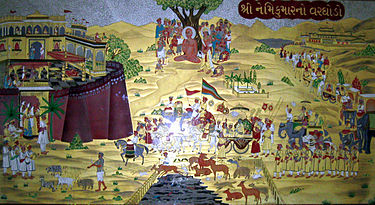- Neminath
-
Nemi 22nd Jain Tirthankara
Idol of Neminath SwamiDetails Alternate name: Arishtanemi Historical date: 3rd Millineum BCE Family Father: Samudravijaya Mother: Shivadevi Dynasty: Harivamsha Places Birth: Sauripura (Dvaraka) Nirvana: Girnar Attributes Colour: Black Symbol: Conch Height: 10 dhanusha (30 meters) Age At Death: 1,000 years old Attendant Gods Yaksha: Gomedh Yaksini: Ambika Neminatha (Devanagari: नेमिनाथ) was twenty-second Jain Tirthankar of the present age (Avsarpini).[1] According to Jain beliefs, he became a Siddha, a liberated soul which has destroyed all of its karma. He is also known as Arishtanemi He along with Rishabha or Adinatha is mentioned in the Rig Veda Samhita. Neminatha was born to King Samudravijaya and Queen Shivadevi at Souripur in the Harivamsha clan. His birth date is the 5th day of Shravana Shukla in the Indian calendar.[1]
Contents
Neminatha as a historical figure
There seems to be no doubt about the existence of Jainism in the 7th century BCE,[2] but the history of Jainism goes back even earlier than of Parsvanatha. The Jain record mentions the names of twenty two Tirthankaras before him. Neminatha, the 22nd Tirthankara of the Jains, was the son of Samudra Vijaya and grandson of Andhakavrishni. Many Jains and some Hindus is said to be a cousin of Krishna, the lord of the Bhagavad Gita (Hindu scriptures).[3][4]
According to both religions, Krishna negotiated his marriage with Rajamati, the daughter of Ugrasena, but Neminatha, empathizing with the animals which were to be slaughtered for the marriage feast, left the procession suddenly and renounced the world. Some writers of the Jain scriptures say that Tirthankara Neminatha was the master of Krishna.
The Andhakavrishnis of Dwaraka in Kathiawar Region of present Gujrat state of India, as a republic is referred to in the Mahabharata, Arthashastra and Ashtadhyayi of Pāṇini.
The name of the Vrishni corporation is also found on a coin which on paleographical grounds dates to the 1st or 2nd century BCE. It seems that the republic was named after Andhakavrishni, the grandfather of Neminatha. If Andhakavrishni is a real person, there seems to be little doubt that his grandson Neminatha was real.
It is mentioned in the Chandogya Upanishads III, that the sage Ghora Angirasa imparted certain instructions of the spiritual sacrifice to Krishna, the son of Devaki. The liberal payment of this sacrifice was austerity, liberality, simplicity, non-violence and truthfulness. These teachings of Ghora Angirasa seem to be the tenets of Jainism. Hence, Ghora Angirasa seems to be a Jain sadhu. The word Ghora Angirasa seems to be an epithet given to him because of the extreme austerities he undertook. It may be possible to suggest that Neminatha was his early name and when he had obtained salvation after hard austerities, he might have been given the name of Ghora Angirasa[citation needed].
In fact, the Jaina traditions about Neminatha or Arishtanemi as incorporated in the Harivamsha, Arittha Nemi Cariu and other works may be corroborated to some extent by the Brahaminical traditions. He is mentioned in some of the hymns of the Vedas but their meaning is doubtful.
In the Yajurveda, he seems to be clearly mentioned as one of the important Rishis[citation needed]]. He is described as one who is capable of crossing over the ocean of life and death, as the remover of violence, and one who is instrumental is sparing life from injury. The Yajurveda probably belongs to the 12th century BCE. This indicates that Neminatha was known at this time and flourished even before.
Physical evidence for existence
The literary evidence seems to be supported by epigraphic evidence. In Kathiawar, a copper plate has been discovered on which there is an inscription[citation needed]. King Nebuchadrezzar I of Babylonia, who was also the lord of Reva-nagara (in Kathiawar of Gujarat) had come to the place (Dwarka) of the Yaduraja. He built a temple and paid homage and made the grant perpetual in favour of Lord Neminatha, the paramount deity of Mt. Raivata. This inscription is of great historical importance. Nebuchadrezzar was living in the 10th century BCE. This indicates that even in the 10th century BCE there was the worship of the temple of Neminatha, the 22nd Tirthankara of the Jains.
He is said to be the contemporary of Krishna, the hero of Mahabharata, which according to the Vedic Religion happened in 3138 BC.
See also
References
- ^ a b Tukol, T. K. (1980). Compendium of Jainism. Dharwad: University of Karnataka. p.31
- ^ The Encyclopædia Britannica s.v. "Jainism" has: "Jainism originated in the 7th–5th century BCE in the Ganges basin of eastern India"
- ^ Helen, Johnson (2009) [1931]. Muni Samvegayashvijay Maharaj. ed (in English. Trans. From Prakrit). Trisastiśalākāpurusacaritra of Hemacandra: The Jain Saga. Part III. Baroda: Oriental Institute. ISBN 978-81-908157-0-3. pp.1-266
- ^ Note: The story of Neminatha or Arishtanemi also contains the story of Krishna, Balrama and the Jain version of the Mahabharata.
Further reading
- Facets of Jainology by Vilas Adinath Sangave Published 2001 by Popular Prakashan
- Article of Dr.Pran Nath The Times of India 19 March 1935
Rishabha or Adinath • Ajitnath • Sambhavanath • Abhinandannath • Sumatinath • Padmaprabha • Suparshvanath • Chandraprabha • Pushpadanta • Sheetalnath • Shreyansanath • Vasupujya • Vimalnath • Anantnath • Dharmanath • Shantinath • Kunthunath • Aranath • Mallinath • Munisuvrata • Naminatha • Neminatha • Parshva • MahaviraCategories:- Tirthankars
Wikimedia Foundation. 2010.



